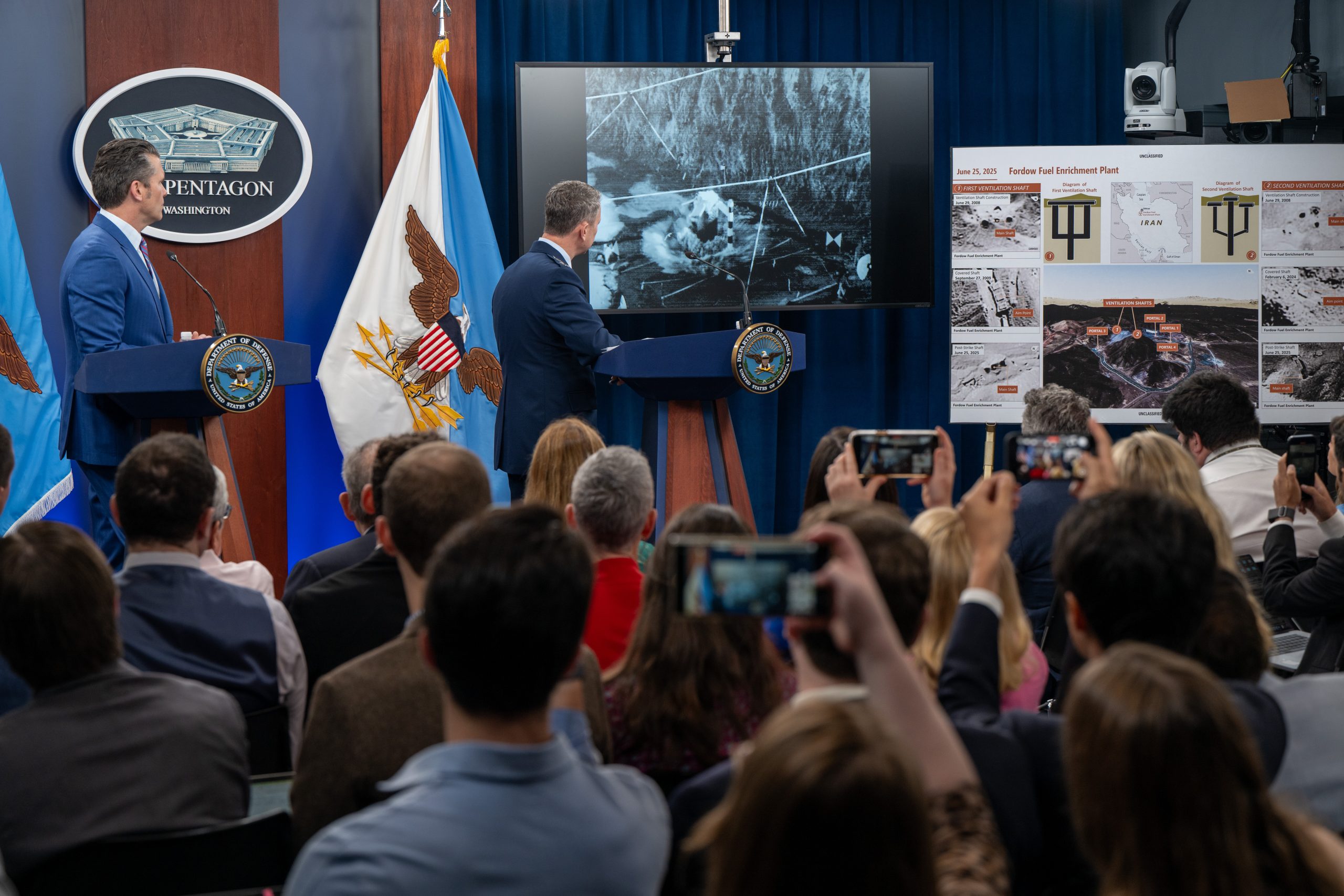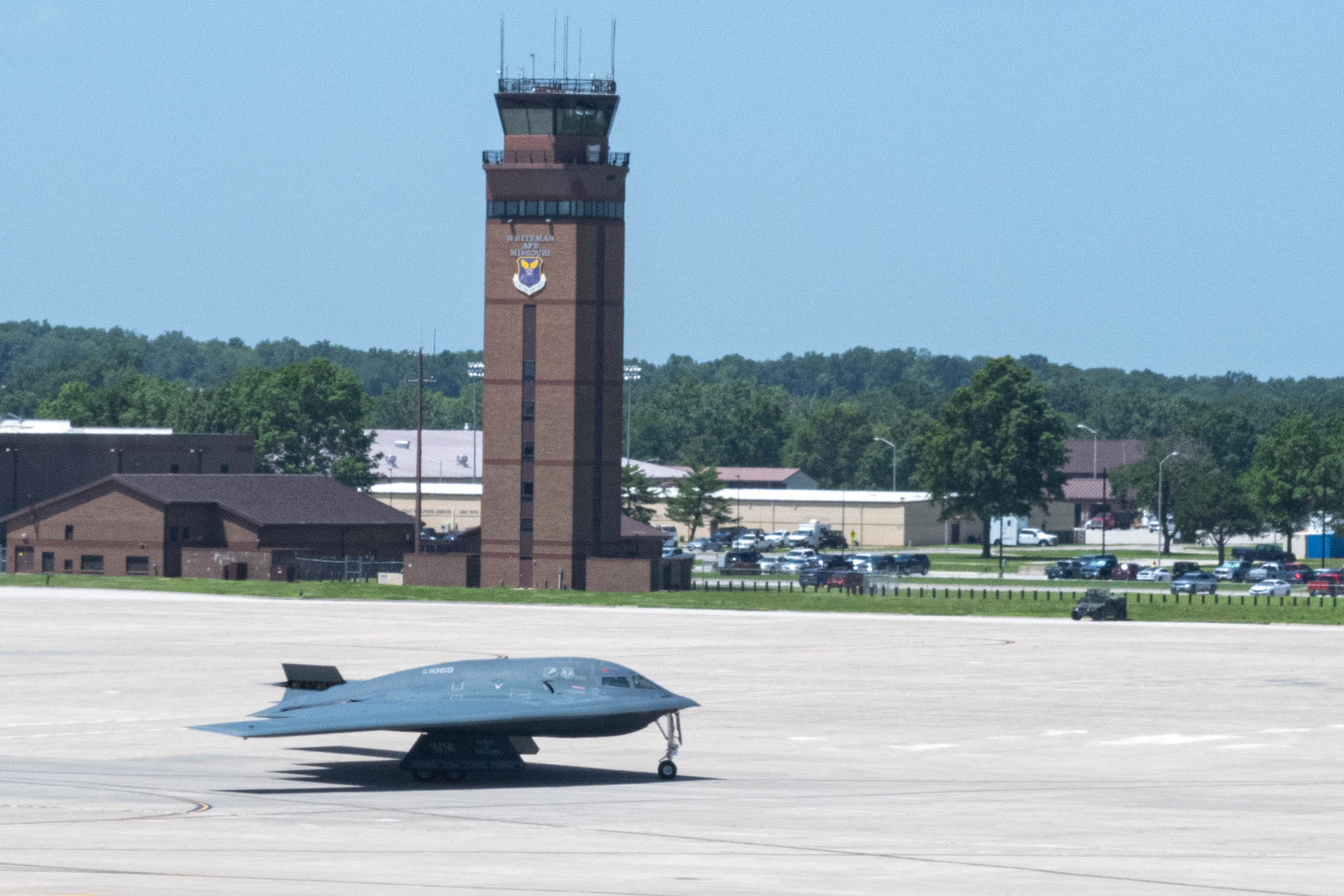Smackdown in Iran
‘15 years of incredible work’—the inside story of Operation Midnight Hammer.
By Chris Gordon
The 36-hour operation to fly deep into Iranian airspace in June and destroy three heavily fortified nuclear complexes began more than 15 years ago with the discovery of a major construction complex among the remote mountains of northwest Iran.
It ended June 22 with the homecoming of seven B-2 Spirit bombers—more than a third of the entire fleet—which had delivered without incident 14 30,000-pound Massive Ordnance Penetrators on Iran’s two nuclear sites.
The U.S. began grappling with the challenge of how to destroy the Fordow mountain complex after Iran began building it in 2006. An analyst at the Defense Threat Reduction Agency (DTRA) was first shown the photos of the site and started work on how to counter it three years later. DTRA is a little-known agency headquartered at Fort Belvoir, Va., a short drive from the Pentagon, with the mission to counter weapons of mass destruction.
“For more than 15 years, this officer and his teammate lived and breathed this single target: Fordow, a critical element of Iran’s nuclear weapons program,” said Chairman of the Joint Chiefs of Staff Gen. Dan Caine. “He watched the Iranians dig it out. He watched the construction, the weather, the discarded material, the geology, the construction materials, where the materials came from. He looked at the vent shaft, the exhaust shaft, the electrical systems, the environmental control systems—every nook, every crater, every piece of equipment going in, and every piece of equipment going out.”
The task was painstaking, with no guarantee the U.S. would ever decide to act on the knowledge.
“We have some incredibly gifted and smart people within the DTRA agency … if you watch “James Bond” films, they’re kind of like those folks that work in Q that come up with these incredible solutions to difficult problems that have tremendous and successful effects in the end,” a senior military official told reporters.
Uranium enrichment is believed to have begun at Fordow in late 2011. The Iranians have insisted their program is peaceful, but Western officials long ago concluded the enrichment was really intended to enable Iran to make its own nuclear weapons.
In March, U.S. intelligence officials warned in a report to Congress that “there has been an erosion of a decadeslong taboo on discussing nuclear weapons in public” in Iran, and that this had “emboldened nuclear weapons advocates within Iran’s decision-making apparatus.” But as of then, intelligence officials said, Iran’s Supreme Leader, Ayatollah Ali Khamenei, had yet to give the go-ahead to produce a nuclear weapon.
Fordow was key to Iran’s ability to do so, and the question of whether or when Iran would take that next step had preoccupied world leaders for more than a decade. “You do not build a multilayered underground bunker complex with centrifuges and other equipment in a mountain for any peaceful purpose,” Caine said.
But how do you destroy a complex buried deep beneath a mountain, intelligence and military analysts wondered. “They began a journey to work with industry and other tacticians to develop the GBU-57,” Caine said.
The GBU-57 Massive Ordnance Penetrator, or “MOP,” is armed with a warhead encased in steel and fused to blow up an estimated 200 feet underground. Under development since 2004 by the Air Force and DTRA, the weapon has been updated and refined multiple times since then.
“Obviously, we did not build Fordow in the United States and test it,” a senior defense official told reporters. “What we do try to do is test in what we call a threat-representative environment. And in this case, we built a test site to test the munitions against, in collaboration with the Air Force and test organization, to try to ascertain the effects that the MOP would have in certain environments.”
At a Pentagon press conference days after the bombing, he shared video from a December 2020 test.
“In the beginning of its development, we had so many Ph.D.s working on the MOP program doing modeling and simulation that we were quietly and in a secret way the biggest users of supercomputer hours within the United States of America,” Caine said. “They tested it over and over again, tried different options, tried more after that. They accomplished hundreds of test shots and dropped many full-scale weapons against extremely realistic targets, all for a single purpose: Kill this target at the time and place of our nation’s choosing.”
Days after Israel launched its air war on Iran on June 12, Iran began working to protect its secret facility, sealing off the ventilation shafts with a massive layer of concrete, Caine said. “The planners had to account for this. They accounted for everything,” he said.
Meanwhile, Israel campaigned to get the United States to finish the job it had started. Only the U.S. Air Force had the means and capacity to destroy those buried facilities.
On June 21, seven B-2s piloted by 14 Airmen, drawn from the Active-duty Air Force and the Missouri Air National Guard, and ranging in rank from captain to colonel, took off from Whiteman Air Force Base, Mo. While other B-2s headed west as a decoy, the seven headed east, crossed the Atlantic and then southward toward Iran. Over the Middle East, the bombers met up with U.S. fighter jets.
Recounting the mission later, Caine said a crew member told him on a video call that, that it “felt like the Super Bowl—the thousands of scientists, Airmen, and maintainers all coming together.”
“We think, we develop, we train, we rehearse, we test, we evaluate every single day,” Caine told a packed Pentagon pressroom. “And when the call comes to deliver, we do so.”
Air Force Chief of Staff Gen. David W. Allvin, testifying at a Senate hearing June 26, said the Airmen involved all deserved credit for their parts in the operation. “There’s a lot of success to go around here,” he said. “They may not have fully understood the geostrategic impact it had, but they knew that was their job to do, and they knew that the mission depended on them. … The Air Force makes the ridiculously complex look routine,” he added. “But that doesn’t come without effort.”
The fighter escorts led the strike package, launching some 30 munitions at Iranian surface-to-air systems, none of which engaged U.S. forces. Whether the Iranian systems were already blinded and rendered useless by the Israelis, or whether they could not combat the stealth jets overhead, or whether they simply held fire is unknown.
Six B-2s attacked Fordow first, dropping six bombs each on the two main ventilation shafts; the first bombs blew off the concrete covers to expose the shafts, then the next four penetrated deep into the facility. The sixth was a “flex” weapon in case of a weapons failure.
A seventh B-2 dropped two more MOPs on the Natanz complex.
The GBU-57s create an “overpressure” effect, generating shockwaves deep underground. The bombs’ fuses are calibrated to explode only after they have penetrated the rock and entered a subterranean facility.
Caine pointed to satellite imagery of the attack and the test video of the weapon’s previous performance as evidence of the strike’s success.
The pilots took off on their mission without telling anyone; families were informed of their secret mission on the evening of June 21—around the same time the world found out the United States had bombed the Fordow and Natanz sites and launched 30 Tomahawk cruise missiles at a third Iranian facility, Isfahan.
Initial reports about the bombing drew the ire of administration officials, who questioned the motives of whoever leaked that first Defense Intelligence Agency assessment, which suggested the attack might have only set Iran back “by months.” That report was issued with “low confidence.”
Asked for his own assessment, Caine declined. “The Joint Force does not do [battle damage assessment] by design,” Caine said. “We don’t grade our own homework. The Intelligence Community does.”
But Secretary of Defense Pete Hegseth said the weapons had a “devastating effect.” While Hegseth says that enriched uranium at Fordow was destroyed, the Iranians also had enriched urnaium at other sites, including Isfahan, which was attacked by cruise missiles and not the MOP. A senior Israeli official said the supply of enriched uranium at Isfahan is believed to have survived, but may be buried and hard to access. Pentagon chief spokesman Sean Parnell said the U.S. believes the strikes “degraded their program by one to two years.”
It remains unclear how much equipment and materiel Iran was able to get out of the Fordow facility before it was attacked. Satellite imagery showed trucks, apparently loading up outside Fordow’s entrance only days before the attack. It is unclear if enriched uranium had been moved from Fordow and if so, how much was removed and where it was taken.
Hegseth said he believed the U.S. hit “what we wanted to hit in those locations.”
There is, however, little doubt that the B-2s executed one of the biggest and most grueling airstrike missions in history. All told, 125 aircraft took part, including refueling tankers, fourth-generation fighters, F-35s, and F-22s. The B-2s flew nonstop for 36 hours.
“Here’s what we know following the attacks and the strikes on Fordow,” Caine said. “First, that the weapons were built, tested, and loaded properly. [Second], the weapons were released on speed and on parameters. [Third], the weapons all guided to their intended targets and to their intended aim points. [Fourth], the weapons, they functioned as designed—meaning they exploded.”
Quoting one of the pilots in a trailing jet, the Chairman recalled his description: “This was the brightest explosion that I’ve ever seen. It literally looked like daylight.”
When the B-2s entered the landing pattern at Whiteman—one four-ship formation and a second three-ship formation—they were greeted with local news crews staged in Knob Noster, Mo. On June 25, Army Gen. Michael “Erik” Kurilla, the head of U.S. Central Command, congratulated the B-2 crews and maintainers in person at Whiteman, and Allvin and Secretary of the Air Force Troy Meink did the same on July 10.
“Operation Midnight Hammer was the culmination of those 15 years of incredible work,” Caine said. “The aircrews, the tanker crews, the weapons crews that built the weapons, the load crews that loaded it. Our adversaries around the world should know that there are other DTRA team members out there studying targets for the same amount of time and will continue to do so.”




